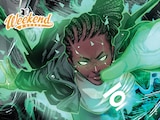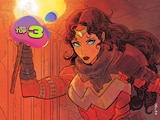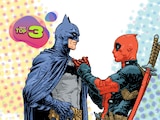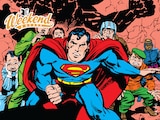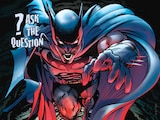What up? It’s ya boy, HubCityQuestion, back at it again. As a professional expert in the study of DC Comics, I hold court every day in the DC Official Discord solving the mysteries and getting the answers you need to know about the DC Universe. In this monthly column, I share my most interesting and notable findings, expounding on my original answers where necessary. We’ll start off this edition by setting some records: the fastest adaptation, the longest Batman acting tenures, and the most prolific modern DC writer.

superthebillybob asks:
What's the shortest amount of time between a character's comic debut and their first live action appearance? I was trying to think of one shorter than Bane, debuting in ‘93 and appearing in Batman & Robin in ‘97. Thanks!
Without further qualifications, the quickest transition from page to screen goes to Ryan Wilder, Kate Kane’s successor as Batwoman. She made her first comic appearance in in October 2020’s Batgirl #50 and debuted on television in January 2021 for season two of Batwoman.
But that answer might be cheating a little since Ryan was developed for TV first and the comics just beat them to it. If we’re only considering characters developed for comics first, then I’d have to go with Honor Guest, the Silencer. She first appeared in her own series which debuted January 2018, and was played by Miranda Edwards just seven months later on season seven of Arrow.
ComedyAlpha asks:
Since we know Kevin Conroy had the longest tenure of playing Batman, who had the second longest tenure of playing him?
Actually, at 32 years from his first episode of Batman: The Animated Series to his posthumous credit in Justice League: Crisis on Infinite Earths – Part Three, Kevin Conroy himself had the third-longest tenure of playing Batman. The longest tenure goes to Adam West, who first played Batman in the 1966 Batman TV series, and continued to portray him until the 2017 animated film Batman vs. Two-Face, for a total of 51 years. The second-longest tenure technically goes to Michael Keaton, who just beats out Kevin Conroy by two years for a 34-year run between 1989’s Batman and 2023’s The Flash.

Twent asks:
Who has written the most DC Comics in the modern age? I know Robert Kanigher has written the most overall, but since those were pretty much all Pre-Crisis, I’m curious.
Geoff Johns, without question. Between his runs on The Flash, Green Lantern, JSA, Justice League, Aquaman, Hawkman, Shazam, Superman, Teen Titans, a whole library of event comics and much more, he's been credited on over 850 DC issues. Robert Kanigher still handily outmatches him, and so might Gardner Fox depending on how you want to count anthology contributions as issue credits. But no other writer in DC history, let alone the modern age, even comes close to his numbers.
Souron1 asks:
Post Emerald Twilight, how did John Stewart get a ring again? He has one in Green Lantern: Rebirth, but I thought Kyle was the only GL at the time.
Early in Judd Winick’s Green Lantern run, a time-displaced, Pre-Parallax Hal Jordan entrusts Kyle Rayner with his own ring. At first, Kyle bestows the ring to his then-girlfriend Jade, who had recently lost her own connection to her superpowers. But after Jade’s innate powers return, Kyle takes an extended leave from Earth and entrusts the extra ring to John to “mind the shop” while he’s away.
REDEMPTION asks:
Do you know what a Lazarus Pit smells like?
The Lazarus Pits are described as having a sulphuric scent in Batman #400. In the Batman Adventures tie-in comics to Batman: The Animated Series, the aroma is more evocatively described as a combination of rotting meat and jasmine. I like that one.

Paul Rabin asks:
Who is being referred to in the above panel? (From a Joker: The World free giveaway I got for Batman Day.)
This sequence, by the Joker: The World anthology team of Felipe Castilho, Tainan Rocha and Marian Gusmão representing Brazil, addresses a horrible chapter in Brazilian history: the Holocaust of Colonia. Over 60,000 patients were tortured and killed in the Hospital Colonia, a corrupt mental institution, between 1906 and its closure in 1980. No one figure was responsible for this horror. Rather, Batman here is referring to the institution itself—a grim reminder of how we treat our mentally ill across the world in real life.
John Jr. asks:
What’s the difference between Batman and Detective Comics, and Superman and Action Comics?
Action Comics and Detective Comics both started in the 1930s as anthology titles and have traditionally featured multiple stories for the majority of their runs. Sometimes, especially in the past 30 years, they’ve been treated as secondary Batman and Superman titles, but you’ll still occasionally see other features in there—Supergirl, for example, is currently running as a backup feature in Action Comics, and throughout Ram V’s recent Detective Comics run, characters like Two-Face, Azrael and Jim Gordon were the focus of their own backup features. Superman and Batman are both entirely dedicated to their title heroes, as spinoffs of their initial successes in their mother anthologies.
(Editor’s note: Action Comics is also currently a weekly title, but it hasn’t always been so! -Truth Telling Tim)

Violet asks:
The above cover introduces new legacy numbering for Green Lantern and I'm very intrigued as to how they reached this number. Is there any way for you to check as to how they came up with it?
I won’t lie. There’s some complicated math involving some hidden figures necessary to arrive at that particular number of issues. I got in touch with DC’s in-house archivist, Benjamin LeClear, to get a closer look at how the Green Lantern issues were counted. Here’s what I discovered:
- The original 1941 Green Lantern series, featuring Alan Scott, accounts for 41 issues.
- The 1960 Green Lantern series, featuring Hal Jordan, ran for 200 issues, changing its title on the cover to Green Lantern Corps with issue #201. However, the internal indica for this Green Lantern series only changes over to Green Lantern Corps after issue 205, so you get 205 issues here. (Additionally, the Green Lantern/Green Arrow split bill period is internally considered to count for Green Lantern legacy numbering, but not Green Arrow.)
- The 1990 Green Lantern series, spanning Hal Jordan’s fall through the solo career of Kyle Rayner, accounts for 181 issues.

- Geoff Johns’ 2005 Green Lantern series accounts for 67 issues.
- The New 52 Green Lantern series accounts for 52 issues.
- Grant Morrison and Liam Sharp’s The Green Lantern accounts for 12 issues. The Blackstars miniseries and The Green Lantern: Season Two are internally considered spinoff titles, and as such are not included in the total count.
- The 2021 Green Lantern series, featuring John Stewart, accounts for 12 more issues.
As with other legacy title amalgamates, annuals, specials, secret files, zero issues and one million issues are not included in the total issue count. Add the issue count from the current ongoing Green Lantern series to the total, and you get 583!

Arkham Batman asks:
Hello! I was wondering, what type of jacket is Question wearing in the above panel?
I’m not a fashion expert, but I happen to know some people who know some things about men’s wear. I got in touch with my most trusted contact, and by his estimation this particular jacket is what is known as a “cruiser jacket,” albeit one likely stylized from memory and partially conflated with the marks of a “club jacket.” Thanks, Tim Rogers!
Jurisdiction asks:
Hey HCQ! I’ve been binge-reading Transmetropolitan recently, and there have been a few times where “Free Steve Chung” is graffitied in the background. Who is Steve Chung?
Good question! To answer that, I’m going to have to give a little bit of a history lesson on a running deep fandom in-joke during the publication of the series. Early on in Transmetropolitan’s letter column page, there was a super fan named Steve Chung who wrote long, voluminous emails to the editor with every issue, dissecting each page panel-by-panel with his comments. The joke among the staff—and other letter column regulars—was that Steve Chung was locked in a cell somewhere with absolutely nothing to do except read the new Transmetropolitan every month, slipped under his cell door. And so, the Transmetropolitan staff and fandom adopted the rallying cry of “FREE STEVE CHUNG.”
I looked up Mr. Chung online to see what he thought about the “Free Steve Chung” movement, and he seems to have taken it in the good fun it was intended. He still touts it proudly as his claim to fame to this day.

Dragon Moth asks:
How did Felicity Smoak go from a barely relevant extra into the deuteragonist of Arrow?
Like the rise of so many great soap opera stars, the answer is serendipity! During that first season of Arrow, a lot of disposable characters were given obscure names from the comics as shoutouts. Felicity was only meant to be in one or two episodes and was haphazardly stuck with a fairly obscure Firestorm supporting character’s name for the few scenes she was written into. But Emily Bett Rickards had such electric chemistry on set with star Stephen Amell that the show kept inviting her back, until she found herself at the center of the story. That’s Hollywood!
Midnight asks:
Is Power Girl stronger than Superman?
Both Power Girl and Superman’s powers fluctuate depending on a variety of factors. I’d say one has no greater capacity for strength than the other.

Amazing Jedi-Man asks:
Has Amanda Waller always been evil in the DC Universe? If not, when did the shift in character start?
I’ll say that Waller’s character has always been complicated. She may be one of the most complex and most frequently misunderstood characters in DC history. As created by John Ostrander and Kim Yale in the 1980s, Amanda Waller was a hard woman who made difficult choices for the greater good. She had been through horrible personal tragedy and made unimaginable sacrifices to make sure no one else would have to suffer like her again. She arrived at the “Suicide Squad” after a series of compromises, but always, despite a harsh exterior, tried to motivate and not punish. Though the threat of killing her squad members who stepped out of line was always there, if you actually read the comics, she rarely ever did it, and only with the greatest reluctance when left with no other choice. She’s a woman who is seen as a villain and has welcomed that image if it meant a safer tomorrow.
Some would say she’s still that woman.
Personally, I think the lead-up from Dark Crisis to Absolute Power represents the shift where Amanda has gone too far, losing sight of the moral principles that had previously always grounded her choices. It’s the story of what happens when a good woman, given access to, well, absolute power loses her way. As the saying goes, absolute power corrupts absolutely.
A DCU fan asks:
Hello Question, what is the current explanation for why 2814 has like six Green Lanterns?
This actually came up in Jeremy Adams’ current Green Lantern run. Hal learns from Tom Kalmaku that during the Millennium event, the Guardians actually hid a backup Central Power Battery on Earth. The human Green Lanterns have proliferated due to its influence and as a means of protecting the planet from its destruction.
J asks:
Hey, I’m a new DC Fan. How many comic books do I have to read to be considered a big fan and be really integrated into the franchise? Thanks!
I’ll tell you a secret, J…the answer is zero. The only requirement to be a DC fan is to be passionate about DC. If you have any desire to be one, then you already are.
That’s all for now. I’ll be back next month with more answers, but until then, you can always hit me up on the DC Official Discord server. Peace!
Alex Jaffe is the author of our monthly "Ask the Question" column and writes about TV, movies, comics and superhero history for DC.com. Follow him on Bluesky at @AlexJaffe and find him in the DC Official Discord server as HubCityQuestion.
NOTE: The views and opinions expressed in this feature are solely those of Alex Jaffe and do not necessarily reflect those of DC or Warner Bros. Discovery, nor should they be read as confirmation or denial of future DC plans.

